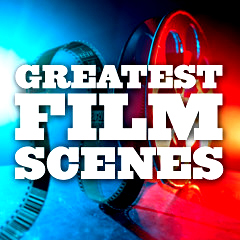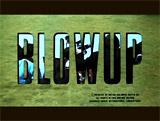
|
Blow-Up
(1966, UK)
In writer-director Michelangelo Antonioni's breakthrough,
absorbing first English language film - it presented his view
of the world of mod fashion; the
taut and provocative film about perception and voyeurism was a combination
murder mystery, a critique of the world of mod fashion, and one of
the greatest films ever made about watching and making movies (literally
composed of a succession of still images).
It followed
the day-and-a-half long quest of an unnamed, mid-20s mod desensitized-to-life,
nihilistic, high-fashion photographer who believed he saw something
intriguingly objective via his camera that turned out to be very
tragic and possibly unreal. Its conceptual plot was similar and influential
for two other film-makers: Francis Ford Coppola's The
Conversation (1974) and Brian De Palma's Blow Out (1981).
Antonioni's story was inspired by the 1959 short story
"Las Babas Del Diablo" ("The
Devil's Drool") by Julio Cortazar. The 111 minute arthouse film
was set in the Swinging mid-60s London; it was an engaging,
provocative murder mystery that examined the existential nature of
reality interpreted and perceived through photography (and also via
painting and pantomime). The film's
cinematographer was Carlo di Palma. The film's tagline was:
Antonioni's camera never flinches. At love without
meaning. At murder without guilt. At the dazzle and the madness
of London today.
The central theme was that the mere presence of an
observer of a phenomenon always altered the reality of the event
due to perception (similar to the theme of Alfred Hitchcock's Rear
Window (1954)). Antonioni's film strongly resonated after the intense frame-by-frame
scrutiny received by the short Zapruder film of the Kennedy assassination
in Dallas (November of 1963).
The countercultural film was nominated for two Academy
Awards (with no wins): Best Director, and Best Original Screenplay
(Michelangelo Antonioni and Tonino Guerra, and Edward Bond), and
it won the Palme d'Or at the Cannes Film Festival in 1967.
It quickly became one of
the most important landmark films of its decade, and was the director's
first international box-office success, made on a small budget of
about $2 million while grossing $20 million. It was also a milestone
in liberalized attitudes toward film nudity and expressions of sexuality
(reportedly the first British film to display full-frontal nudity),
and forced changes in Hollywood's Production Code that led to the
MPAA rating system in 1968.
- the title credits were viewed atop a verdant green
lawn (at Maryon Park, later a crucial location in the film), with
the transparent letters revealing a bikinied model undulating during
a photo-shoot on a roof-top against a light blue sky
- in the film's opening, a group of white-faced and
masked mime pranksters caroused and drove through the streets in an open Land Rover, urging cars
and drivers to contribute to their charity and activist causes
- a hip, disinterested, often introverted and jaded fashion photographer
Thomas (David Hemmings) had just spent the night in Camberwell
Reception Centre, a shelter or hostel (dosshouse or flophouse)
for sick and elderly homeless tramps - to take photos of the dark
side of life for a photo-book; unexpectedly, the disheveled male
then drove off - unexpectedly - in his parked Rolls-Royce Silver
Cloud III convertible; Thomas's car was surrounded and besieged by
the pale-faced pranksters
- Thomas was an hour late for an appointment in
a photo studio to engage in a frenzied camera-shoot scene with
various 'birds'; during the solo shoot, he snapped
photos of skinny, writhing, self-absorbed model Veruschka (Herself);
she was wearing a loose, low-cut glittery dress with open sides and
was obviously naked underneath; he urged her orgasmically as he straddled
her on the floor with his phallic camera to give everything for his art:
- "On your back. Go on. Yes. Now really give
it. Come on. Come on. Work, work, work! Great. Great. And again.
Come on. Back. Back. Arms up. Arms up.
Stretch yourself, little lady. Great. And again. Go on. Go. Go.
That's great. That's it! Keep it up. Lovely. Yeah, make it come.
Great. No, no, head up, head up. Now for me, love. For me. Now!
Now! Yes! Yes! Yes!"
|
Orgasmic Fashion-Model Photo Shoot With Veruschka
(Herself)
|
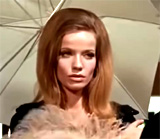
|
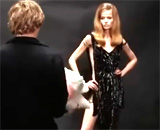
|
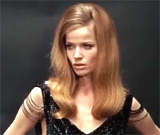
|
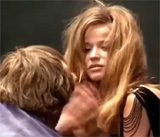
|
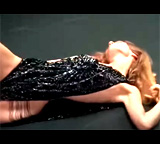
|
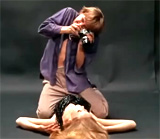
|
- as he was leaving the studio,
he also was called upon to photograph (using a tripod) a vapid
flock of five, unsmiling, stationary "birds" (Melanie Hampshire,
Jill Kennington, Peggy Moffitt, Rosaleen Murray, and Ann Norman); they
were standing diagonally before rectangular black glass panes; he
was critical of them for chewing gum and assuming "terrible"
stylized poses like brain-less mannequins; seeming bored,
cranky, demanding, and slightly contemptuous, he cut short the photo-shoot
when he realized that he had tired them
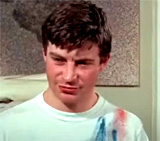
Bill (John Castle), Artist Friend
|

Patricia (Sarah Miles), an Unhappily Married Wife
|
- afterwards across the yard from his own home's studio,
Thomas spoke briefly with his neighbor and artist-friend Bill
(John Castle) about his impressionistic paintings, and with Bill's
unhappily-married wife Patricia (Sarah Miles); back in his own
photo studio, Thomas was confronted by two naive young wanna-be
teenage models or "dolly birds" (blonde Jane Birkin and brunette Gillian Hills) in
his studio (39) who wanted their pictures taken, but he claimed he was too busy
- he drove off to visit a small, cluttered,
and dusty antiques shop looking for landscapes; the elderly, cranky
shopkeeper (Harry Hutchinson) warned that there were no cheap bargains
for him ("There are no cheap bargains here. You are wasting your time")
- then, Thomas innocently followed and took
photographs in East London in the nearby serene Maryon Park; his
first subjects were pigeons, a litter collector, wind blowing
through trees, and the wide expanse of green grass; and then he
came upon what he thought was a tryst between lovers (a distant
view of a young female in a tight gray skirt with a black kerchief,
and a middle-aged man in a light-gray suit embracing)
- he furtively captured the scene
in his voyeuristic camera, but then the female approached angrily
and protested his intrusion on their privacy: ("Stop it. Stop
it! Give me those pictures. You can't photograph people like that...This
is a public place. Everyone has a right to be left in peace");
when she tried to grab his camera away, he refused: "What's
the rush?"; afterwards, she ran off, and stood momentarily by
a distant tree and low-lying bushes far away at the other
end of the meadow
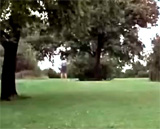
The One Incriminating Frame - A Body Under a Bush Next to a Tree
|
- [Note: On close inspection, she was standing
next to a body lying face up under a bush next to a tree, although
most viewers would not notice it on first viewing.]
- during a second visit to the antiques shop, on an
impulsive whim, Thomas bargained with the young pretty shop owner
(Susan Brodrick), insisting on buying (for 8 pounds) a
huge, vintage wooden airplane propeller for decorative purposes; she
helped him to try and load the oversized, heavy and unwieldy piece
of art-junk into the back of his convertible, but then he arranged for a delivery
- afterwards in a fancy restaurant, Thomas shared
his surreptitiously-taken photos of homeless men from the night
before with his bearded writer/collaborator Ron (Peter Bowles);
he was preparing to have some of his photos included
in a high-brow, documentary photo-essay book they were producing
together - it was his own purposeful personal project; as he returned
home, he was pursued by a 4-door dark gray sedan driven by a suspicious
stranger (Dyson Lovell) with the park's Female in the passenger seat
- at his studio/home as he was about to unlock the street door, the Female (Vanessa Redgrave)
from the park desperately and seductively asked again for the film;
he confronted her: "What's so important about my bloody pictures?";
she nervously claimed her private life was disastrous (was she involved in adultery or something more sinister?),
and would be damaging to her, but he countered:
- "So what?
Nothing like a little disaster for sorting things out"

|

|

|
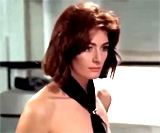
|

|
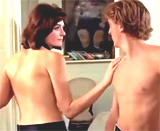
|
|
The Demanding Female Desperate to Get the Roll
of Incriminating Film From Thomas in His Photo Studio
|
- she begged and bargained for the roll of incriminating
film that he had shot of her in the public park with an unidentified,
middle-aged man; she offered her body and sexually submitted herself
to him: "Why didn't you say what you want?"; she
eventually offered sexual favors by going topless, and although he
basically ignored her, Thomas gave her a roll of undeveloped film
but kept the one she wanted; they were briefly interrupted by the
delivery of the propeller; afterwards as they smoked cigarettes together
(it was unclear whether they had sex together), she happened to glance
at her watch, hurried off ("It's late")
and slipped on her blouse before leaving
- an exciting montage presented Thomas going through
the various stages of the pictures' development - printing and
magnified enlargement in his darkroom; as tension heightened, he
pinned the pictures on the wall of his living room - in sequence
- giving them life as if they were individual frames in a motion
picture; to his shock, Thomas believed he saw
a shadowy figure and a hand holding a gun in the bushes behind
a fence, and possibly a dead body; he imagined
that he had witnessed a scene of sexual intrigue and now the riveting
possibility that he may have accidentally obtained visual, criminal
evidence of a murder; was the man in the bushes a voyeur, part
of a deadly threesome, or a threatening individual with a weapon, and
had a murder-for-hire been thwarted?
|
Thomas Storyboarding the Photos - A Possible Murder?
|
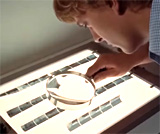
|

|

|
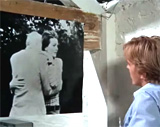
|
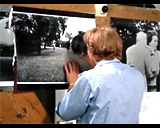
|

|
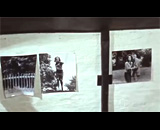
|
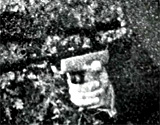
|

|
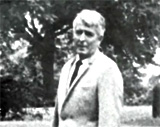
|
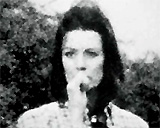
|

|
- Thomas had finally become aroused by something he
could become passionate about; he theorized that his picture-taking
might have foiled or interrupted a potential murder attempt; he
phoned Ron with ecstatic news:
- "Something fantastic's happened.
Those photographs in the park, fantastic! Somebody was trying
to kill somebody else. I saved his life"
- Thomas then experienced a controversial, sexual
encounter with the two giggling teen females who stopped
by on their second visit; while trying on clothes, the skinny blonde
was stripped of her clothes by Thomas, and then she wrestled her
dark-haired friend and she was stripped too, claiming:
"She's got a better figure than me"; eventually in a pre-threesome
orgy sequence, the trio ended up frolicking and rolling around on
an extended roll of purple backdrop paper as they tried to disrobe
each other; later in the evening, exhausted by the romp, he stood
up - and then completely ignored the two groupies, but promised photos
with the disappointed girls the next day
|
The 2nd Visit From Two Aspiring Teen
Models
|

|

|
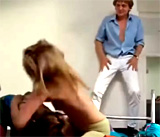
|

|
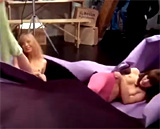
|
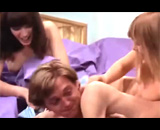
|
- once again, Thomas returned to further study the
photographs, and imagined a more riveting possibility - that he
may have accidentally recorded and obtained visual, criminal evidence
of an actual murder - the figure hiding in the bushes with a gun
in his hand may have shot and killed the female's elderly paramour
- Thomas drove back to the park for a nighttime
visit, with the haunting sound of the wind blowing through
the trees; he discovered a scene of murder due to the perfectly-posed,
gray-haired man's corpse (the cheating Female's middle-aged lover?)
next to some bushes at the far-end of the park; without his camera,
he couldn't document his find; was the body real, or only a creative
figment of his imagination?; he was scared off by a twig snapping
- after returning home, in his next-door neighbor's
apartment, Thomas watched as Patricia was underneath her husband
Bill who was on top making love to her; she wordlessly entreated
Thomas in their flat to position himself and stay in view nearby
so she could achieve orgasm - his presence aroused her passion
- upon his return to his photographic studio, Thomas
saw it had been ransacked and vandalized; he shockingly realized
that someone had stolen all of his negatives and blown-up
prints of the incident, except for one large grainy and fuzzy close-up
of the body on the ground
- when Patricia stopped after her love-making session,
he asked: "Do you ever think of leaving him?" and she responded: "No,
I don't think so"; he shared with her that he saw an
unidentified "someone" shot
and killed in the park that morning; she asked a very grounded,
highly-crucial question: "Are you sure?" and uncertainty grew in
his mind; before leaving, she also inserted another request about her relationship: "Will
you help me? I don't know what to do," but the subject quickly changed
- while driving back to the park, he caught
a fleeting glimpse of the female from the park window-shopping on
a sidewalk, but then she vanished in a crowd; Thomas also found himself
at an indoor Yardbirds rock concert in the Ricky Tick Club; he watched
as the group's lead member Jeff Beck smashed
his guitar into an amplifier and then stomped on it; Thomas seized
the broken guitar piece and ran off with others in hot pursuit, but
then discarded it
- he became sidetracked at a fashionable and elegant
cocktail party in a gated apartment building, where Ron and others
(including Veruschka who had lied about going to Paris) were smoking
joints; Thomas attempted to explain his experience in the park with
Ron ("I want you to see the corpse. We've got to get
a shot of it"), but the disoriented Ron was uninterested and disbelieving;
when Ron finally asked: "What did you see in that park?", Thomas
capitulated and answered that he also could not comprehend or explain
what he saw: "Nothing" - it was the film's last word of dialogue
- eventually by morning, Thomas returned to
the park to find the body missing and the murder evidence had vanished;
Thomas continued to be befuddled by his experience with the photographs,
and began wandering around
- in the final enigmatic scene, Thomas observed as
the bizarrely-dressed, clownish university students in white-face
careened into the park in their overloaded Land Rover; two of the
mimes entered a tennis court to play a mute game of tennis with
invisible, non-existent tennis rackets and ball (the soundtrack
picked up the sound of the tennis ball however); Thomas volunteered
to join in the charade with them, and threw the imaginary ball back
to them
- the film ended with an aerial view of Thomas as a
tiny and solitary figure standing at a distance in the middle of
a grassy field in the park near the tennis court, with his camera
in his hand; he faded from view just before the words THE END zoomed
forward

The Mime Pranksters At a Tennis Court
|
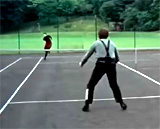
Muted and Pantomimed Game of Tennis Without Rackets
or Balls
|
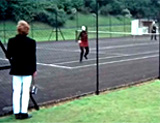
Thomas Watching and Then Participating
|
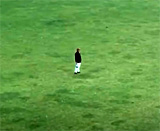
Aerial View Ending With Thomas' Disappearance in a
Field
|
|

Photographer Thomas (David Hemmings) Emerging From Flophouse
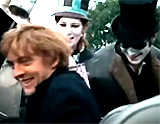
White-Faced Mime Pranksters Surrounding Thomas' Convertible


2nd Set of Models Posing For Photo Shoot

First Visit of Two Teen Wanna-Be Models - (l to r): (Jane Birkin
and Gillian Hills)

Elderly Antiques Shopkeeper (Harry Hutchinson)

Thomas In Maryon Park With His Camera
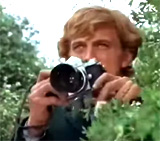
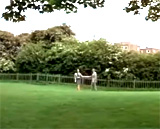

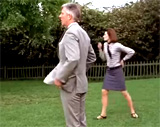
Thomas Observing and Taking
Pictures of an East London Park Rendezvous Tryst


The Female (Vanessa Redgrave) Angrily Demanding The Roll
of Film
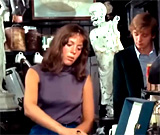
Thomas Speaking to the Pretty and Young Antiques Shop Owner (Susan Brodrick)

Thomas' Purchase of a Wooden Airplane Propeller

Thomas Sharing Photos From the Mens' Hostel with Ron (Peter Bowles)



Thomas After Blowing Up the Photos - He Examined Them in Detail
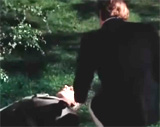

Thomas Found The Body in the Park During a Return Nighttime Visit
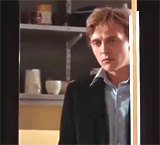
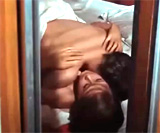

Thomas' Witnessing of a Sexual Encounter Involving His
Neighbor Patricia
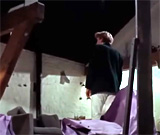
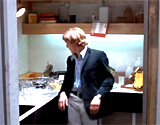
Thomas' Ransacked Apartment
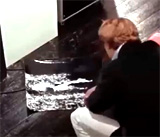
The Only Grainy Picture Remaining
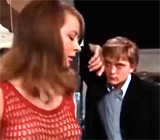
Patricia's Visit With Thomas After Love-Making With Her Husband
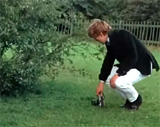
The Body Was Missing the Next Day Under the Bush in the Park
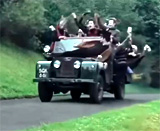
The Pranksters Driving Into the Park
|
